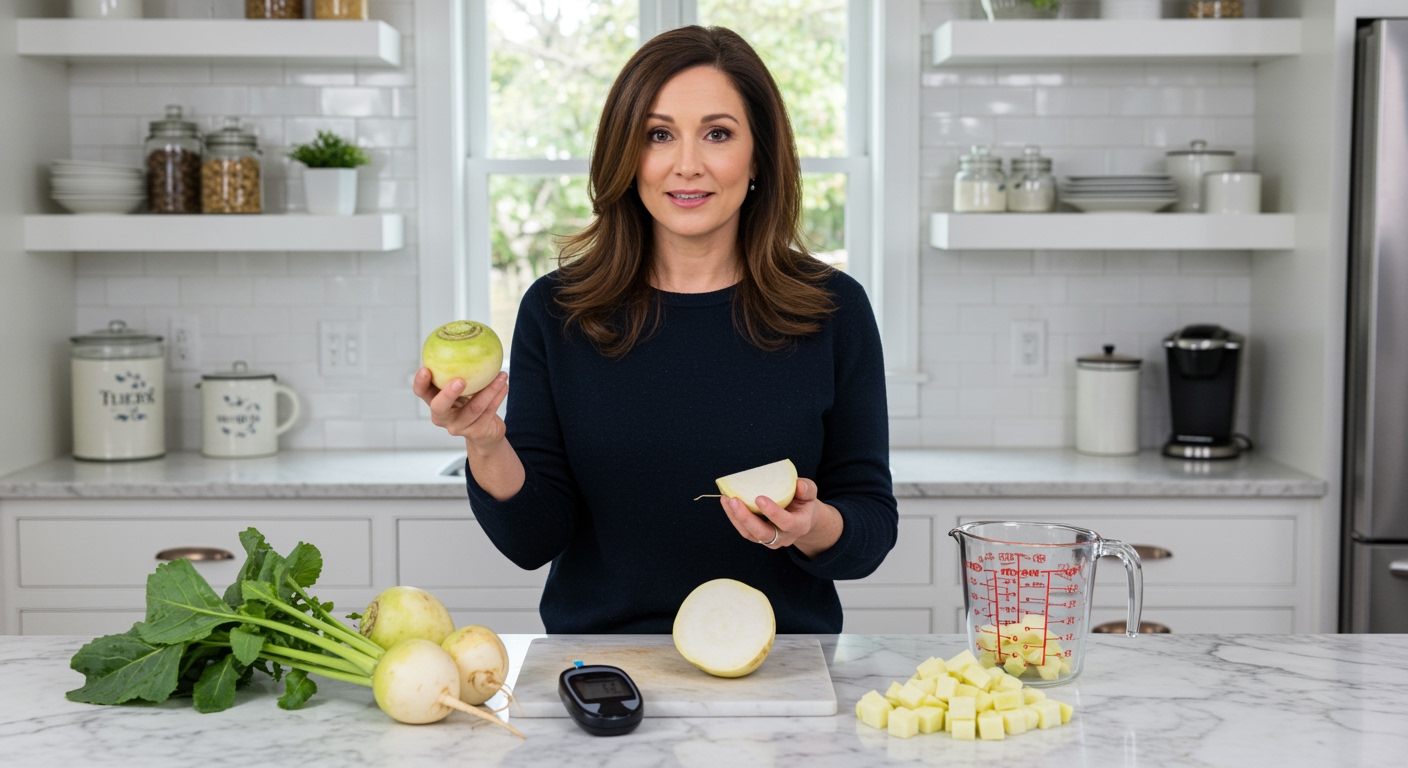✪ Key Takeaway: Turnips are excellent for diabetes with a low glycemic index of 35 and only 6g carbs per cup.
Introduction
You walk down the produce aisle and see turnips sitting there like forgotten cousins of potatoes.
Most people with diabetes avoid root vegetables because they think all of them will send blood sugar through the roof.
Hi, I’m Abdur, your nutrition coach and today I’m going to explain why turnips might be the diabetes-friendly root vegetable you never knew you needed.
What Makes Turnips Different From Other Root Vegetables?
Turnips belong to the cruciferous family along with broccoli and cabbage.
This white root vegetable contains only 6 grams of carbohydrates per cup compared to 26 grams in potatoes.
The glycemic index of turnips sits at a low 35, which means they cause a gradual rise in blood sugar rather than a sharp spike.
Turnips also pack 2 grams of fiber per cup, which slows down sugar absorption in your digestive system.
The fiber creates a gel-like substance in your stomach that acts like a natural brake on glucose release.
✪ Fact: Turnips contain 90% water, making them naturally low in calories and carbs.
How Do Turnips Affect Blood Sugar Levels?
When you eat turnips, your blood sugar rises slowly and steadily instead of spiking quickly.
The low glycemic load of turnips means a typical serving has minimal impact on your glucose levels.
Research shows that foods with a glycemic index below 55 help maintain stable blood sugar throughout the day.
Turnips also contain natural compounds called glucosinolates that may improve insulin sensitivity.
These compounds work by helping your cells respond better to insulin signals, which means glucose gets absorbed more efficiently.
The combination of low carbs, high fiber, and beneficial compounds makes turnips a smart choice for blood sugar management.
✪ Pro Tip: Eat turnips with protein or healthy fats to further slow glucose absorption.
What Nutrients Do Turnips Provide For Diabetics?
Turnips deliver vitamin C at 30% of your daily needs per cup, which helps reduce inflammation linked to diabetes complications.
The potassium content in turnips supports healthy blood pressure, a crucial factor for people managing diabetes.
You also get folate and manganese, nutrients that support proper glucose metabolism in your cells.
The antioxidants in turnips help protect your blood vessels from damage caused by high blood sugar over time.
These antioxidants work by neutralizing free radicals that form when glucose levels fluctuate.
Turnips provide these benefits with only 28 calories per cup, making them perfect for weight management alongside diabetes control.
✪ Note: Turnip greens are even more nutritious than the root itself and equally diabetes-friendly.
How Should You Prepare Turnips For Best Blood Sugar Control?
Raw turnips have the lowest impact on blood sugar because cooking breaks down some fiber structure.
Try grating raw turnips into salads or eating them as crunchy snacks with hummus or nut butter.
When cooking, steaming or roasting preserves more nutrients and fiber than boiling.
Avoid adding high-sugar sauces or honey glazes that can spike your blood glucose unnecessarily.
Season turnips with herbs, spices, olive oil, or vinegar to enhance flavor without adding carbs.
Mashed turnips make an excellent low-carb substitute for mashed potatoes at dinner.
You can also dice turnips and add them to soups or stews where they absorb flavors while maintaining their blood sugar benefits.
✪ Pro Tip: Start with half-cup servings to see how your body responds before increasing portions.
Are There Any Concerns With Eating Turnips For Diabetes?
Turnips are generally safe for most people with diabetes when eaten in reasonable portions.
Some people experience digestive discomfort when eating large amounts of cruciferous vegetables like turnips.
If you take blood thinning medications, talk to your doctor because turnips contain vitamin K.
People with thyroid conditions should moderate their intake of cruciferous vegetables, though normal portions are usually fine.
The goitrogens in turnips can interfere with thyroid function only when consumed in very large quantities.
Always monitor your blood sugar when trying new foods to understand how your individual body responds.
✪ Note: Cooking turnips reduces goitrogen content if you have thyroid concerns.
The Bottom Line
Turnips are actually one of the best root vegetables for people managing diabetes due to their low glycemic index and minimal carb content.
Smart food choices happen when you look beyond assumptions and examine the actual nutritional facts.
I would love to hear about your experience with turnips or any questions you might have about incorporating them into your diabetes meal plan in the comments below.
References
At NutritionCrown, we use quality and credible sources to ensure our content is accurate and trustworthy. Below are the sources referenced in creating this article:
- Signos: Turnip Glycemic Index
- January AI: Turnips Glycemic Index
- Diabetes Telecare: Turnips and Diabetes A Low Carb Root for Better Blood Sugar
- Curex: Turnip Glycemic Index Nutrition Facts





